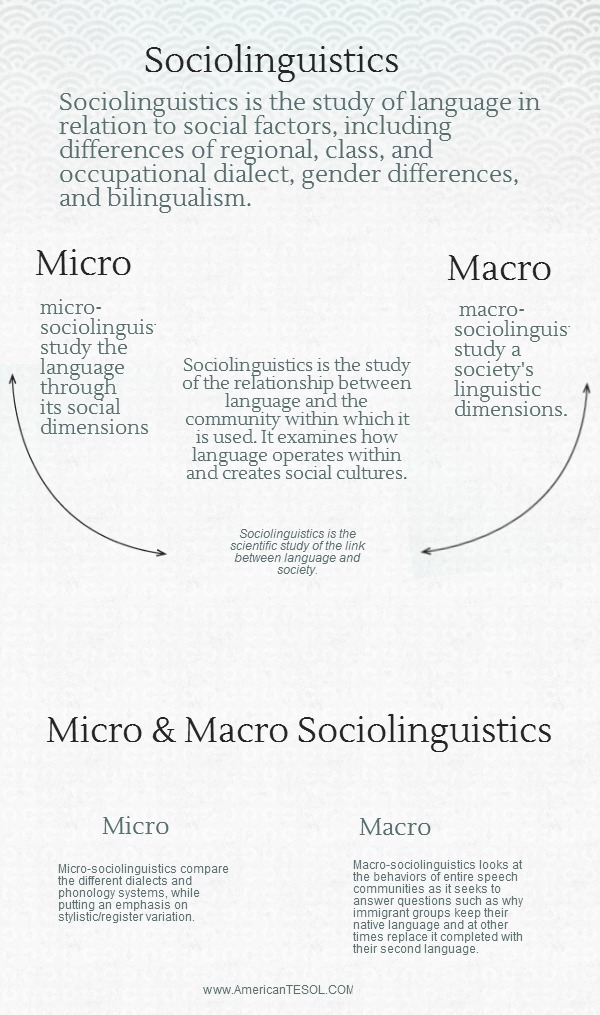Sociolinguistics is a vital field for TESOL teachers, as it delves into the relationship between language and the community within which it is used. This branch of linguistics not only examines how language functions in social contexts but also how it shapes and reflects the social identities of individuals and groups. For TESOL teachers, understanding sociolinguistics can provide deeper insights into the ways learners acquire language, adapt to new linguistic environments, and maintain or shift their linguistic behaviors based on cultural and social influences.
What is Sociolinguistics?
Sociolinguistics is the study of how language and society interact. It looks at the social functions of language and how people use language differently in various social contexts. This discipline explores questions such as how dialects develop, why people change their language use based on their audience, and how language can influence social identity, power dynamics, and cultural integration.
For TESOL teachers, understanding sociolinguistics means recognizing the ways in which students’ social backgrounds, communities, and cultural practices influence their language learning and usage. By being mindful of these factors, teachers can tailor their teaching methods to better support students’ linguistic and cultural needs.
Micro vs. Macro Sociolinguistics: A Key Distinction
Sociolinguistics can be divided into micro-sociolinguistics and macro-sociolinguistics, two subfields that provide different lenses through which we can study language in society.
1. Micro-Sociolinguistics: The Study of Language through Social Dimensions
Micro-sociolinguistics focuses on the detailed and specific aspects of language use within social contexts. It investigates how language varies across different social groups, regions, or even individuals. For instance, micro-sociolinguistics looks at dialect differences, phonological variations, and the ways in which language reflects identity and group membership. It also explores register variation, which refers to how speakers adjust their language depending on context—such as speaking formally in a job interview but informally with friends.
Key Concepts in Micro-Sociolinguistics:
- Dialect Variation: How people from different regions or social groups speak differently, even when using the same language.
- Phonology: Differences in pronunciation, such as accents, that can signal a speaker’s regional or social background.
- Stylistic/Register Variation: The adjustments people make to their speech based on social settings. For example, students may speak one way in the classroom and another way with friends.
- Code-Switching: The ability to switch between different languages or language varieties depending on the audience or situation.
Example for TESOL Teachers: A micro-sociolinguistic approach can help TESOL teachers understand why a student from a specific region or background may speak English differently from their peers, and why they might use a different variety of English in casual conversations versus formal writing.
Fun Fact: Did you know that in some dialects of English, “y’all” (used in Southern American English) serves as a plural form of “you,” filling a grammatical gap in standard English?
2. Macro-Sociolinguistics: The Study of Society through Linguistic Dimensions
While micro-sociolinguistics zooms in on individual language practices, macro-sociolinguistics looks at broader patterns within speech communities. It explores how language and society interact on a larger scale, focusing on entire groups and cultures rather than individuals or specific social settings.
Macro-sociolinguistics asks questions like:
- Why do immigrant groups sometimes keep their native language across generations, while others shift entirely to the dominant language of their new country?
- How do governments and educational institutions influence language policies, like promoting bilingualism or mandating a national language?
- What factors lead to language shift, maintenance, or even language death?
Key Concepts in Macro-Sociolinguistics:
- Language Shift: The process where a community replaces its native language with another language, often due to economic or social pressures.
- Language Maintenance: When a speech community continues to use its native language, even when surrounded by a more dominant language.
- Language Planning and Policy: Government efforts to regulate language use in a country or region, such as promoting official languages or supporting endangered languages.
Example for TESOL Teachers: A macro-sociolinguistic approach can help TESOL teachers understand why students from certain immigrant communities may maintain their first language at home while learning English at school. It can also provide insights into how language policies (like English-only education) affect students’ language development and social integration.
Fun Fact: The phenomenon of “Spanglish”, a blend of Spanish and English spoken by many Latino communities in the United States, is a perfect example of macro-sociolinguistics in action, as it shows how languages merge and evolve based on social and cultural dynamics.
Why is Sociolinguistics Important for TESOL Teachers?
Sociolinguistics provides valuable insights into the complexities of language learning and use, which is especially important for TESOL teachers working with diverse student populations. Understanding sociolinguistics helps teachers:
- Recognize Dialectal and Cultural Differences: Students may speak different varieties of English or come from cultures with distinct linguistic norms. Recognizing these differences allows teachers to avoid stigmatizing non-standard speech patterns.
- Promote Inclusivity: By understanding the social functions of language, teachers can create an inclusive classroom environment where all language varieties are respected and valued.
- Support Bilingual and Multilingual Learners: Sociolinguistics sheds light on how students balance their native language with English, allowing teachers to offer more targeted support for bilingual or multilingual learners.
Practical Applications of Sociolinguistics in TESOL
- Using Code-Switching as a Learning Tool: Rather than discouraging students from code-switching, TESOL teachers can embrace this practice as a valuable linguistic skill. By allowing students to switch between languages, teachers can help learners develop flexibility in communication and understanding of language contexts.
- Addressing Language Prejudice: Sociolinguistics reminds us that no dialect or accent is “better” or “worse” than another. TESOL teachers can play an important role in combating language prejudice by highlighting the richness and legitimacy of all language varieties.
- Encouraging Cultural Exchange: Understanding the connection between language and culture allows teachers to create lessons that embrace students’ cultural backgrounds. Incorporating cultural discussions into lessons not only enriches language learning but also fosters mutual respect and understanding among students.
Conclusion
Sociolinguistics offers TESOL teachers a powerful framework for understanding the relationship between language and the social world. By distinguishing between micro and macro sociolinguistics, teachers can approach language teaching with a deeper awareness of how students’ social environments and cultural backgrounds shape their language use. Whether focusing on the intricacies of dialect variation or the broader dynamics of language in society, sociolinguistics provides essential tools for creating more effective, inclusive, and culturally responsive classrooms.



